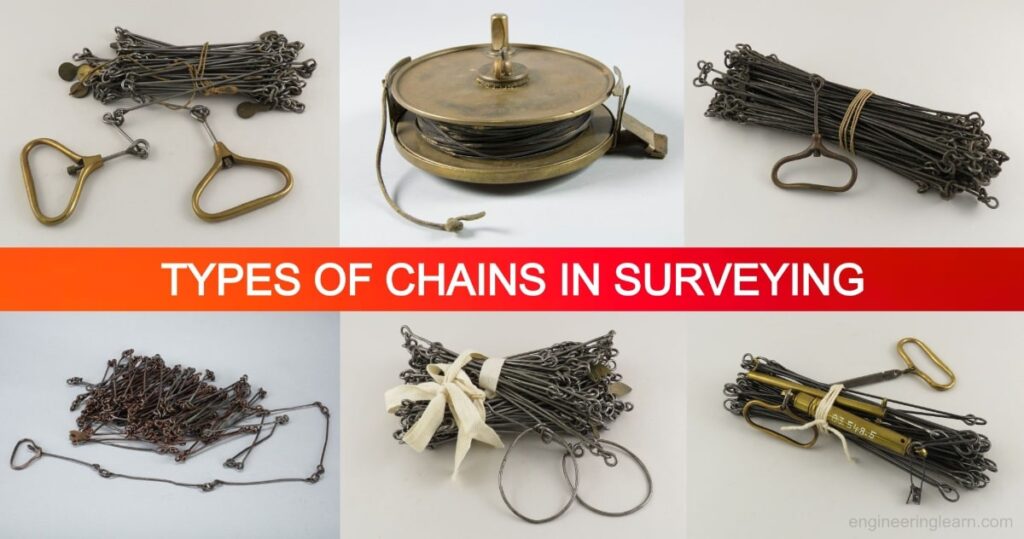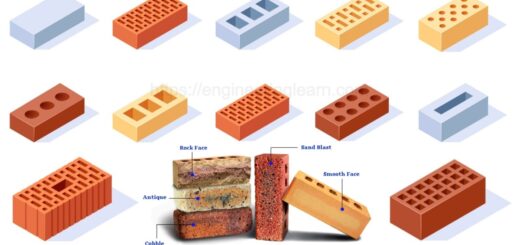What is Chain Surveying? 5 Types of Chains in Surveying, Principles, Errors, Procedure, Advantages & Disadvantages

Introduction
What is Chain Surveying? 5 Types of Chains in Surveying, Principles, Errors, Procedure, Advantages & Disadvantages: – Chains are the measuring instrument utilized in surveying formed by the 100 links of 4mm stirred mild steel wire. These rings give flexibility or adaptability to the chains. Each aspect of life requires some measuring units. Measurements are utilized to accomplish the work exactly and precisely. Let it be from kitchen to office, wherever measurements are utilized. So as in engineering computation or estimations hold an exceptionally more prominent role in the development or reviewing or some other viewpoint. There are different units of measurement like meters, centimeters, feet, inches, a section of land, yards and the rundown goes on. Same as units there are different instruments utilized in the estimations of any element. One of the instruments utilized in measurement is chains.
What is Chain Surveying?
The term chain surveying in survey work alludes to the measurement of distances with a chain or a tape. Among various types of land surveying, chain surveying is one of them. In chain surveying, linear measurements are only made, and no precise measurements are taken in this kind of surveying.
Here it is examined the thing is chain surveying, principles of chain surveying, types of chain in surveying, chain surveying instruments, the procedure of chain surveying, and their advantages and disadvantages.
Principles of Chain Surveying
- The primary principle of chain surveying is to divide the survey plot into little survey regions by triangulation strategy.
- The measurements are utilized so the surveyed drawing can be plotted on paper.
- The chain survey is otherwise called chain triangulation since the triangulation strategy is the principle of chain surveying.
- The triangles that are formed by the triangulation strategy ought to look like an equilateral triangle shape.
- The formed triangle ought to be a well-conditioned triangle and those that are practically symmetrical in shape are known as well-conditioned triangle.
- On the off chance that there is a three-sided survey area and the sequence and lengths of its three sides are noted, then the plan of the survey area can be drawn without any problem.
- In the event that the survey area incorporates more than three boundaries, it’s at this point insufficient to measure side lengths completely.
- The field measurements ought to be excessively organized with the end goal that the region can be plotted by setting down triangles and various plans should be ready to fulfill the condition.
What kind of Parts of Chains are used in Surveying?
The chain comprises many small parts utilized for handling or reading the measurements.
- At the end chain is provided with a metal or brass handle with a swivel joint so it tends to be easy to roll or unroll the chain without curving and knots.
- At every tenth link is provided with a count of one teeth, the twentieth link with a count of two teeth, and so on till the 40th link. This is provided for the simple reading of measurements
- At the center of the chain is provided a circular Talley utilized for simple reading.
Types of Chains in Surveying
Contingent upon the length of the chain, these are divided into the following types:-
1. Metric Chains: ( Types of Chains in Surveying )
Metric chains are the most commonly utilized chain. These types of chains come in different lengths like 5, 10, 20, and 30 meters. Most commonly utilized is 20m chain. Tallies are provided at every 2m of the chain for quick reading. Every link of this kind of chain is 0.2m. The total length of the chain is set apart on the brass handle toward the end.
2. Engineer’s Chain: ( Types of Chains in Surveying )
This chain comes in 100ft length. It comprise 100 links each link being 1ft long. At each 10 link, a brass ring or tags are provided to sign 10 links. Readings are taken in feet and decimal.
3. Revenue Chain: ( Types of Chains in Surveying )
The standard size of this sort of chain is 33ft. The number of links or connections is 16, each connection being 2 ft. This chain is commonly utilized in the cadastral survey.
4. Steel Band or Band Chain: ( Types of Chains in Surveying )
These types of chains comprise a long narrow strip of steel of uniform width of 12 to 16 mm and thickness of 0.3 to 0.6 mm. This chain is divided or partitioned by brass studs at each 20cm or instead of brass studs, the band chain might have graduated engraving as a centimeter. For simple use and functionality, band chains are twisted on steel crosses or metal reels from which they can be easily unrolled. These steel bands are accessible in 20m and 30m lengths and a width of around 12-16mm.
5. Gunter’s Chain or Surveyor’s Chain: ( Types of Chains in Surveying )
A Surveyor’s chain or Gunter’s chain length is 66 feet and comprises 100 links, each link being 0.66 feet or 7.92 inches long. In this type of chain surveying the length of 66 feet was adopted for comfort in length measurement, has 10 sq. chains are equivalent to 1 acre. Likewise, when linear measurement is required in furlongs and miles, these chain is more convenient as 10 chains make 1 furlong and 80 chains make 1 mile.
Testing and Adjustment of Chain
As the chain is a metal made, it might go through many changes because of temperature impact or human error, and so forth. So for all lengths of chain a resilience is given, 5m chain = + or – 3mm 10m chain = + or – 3mm 20m chain = + or – 5mm 30m chain = + or – 8mm.
(i) Chain length shorten due to
- Bending of links.
- Sticking mud in the rings
(ii) Chain length increases due to
- Opening of small rings.
- Wearing surfaces.
(iii) Chains may be tested with respect to
- Steel tape
- Permanent test gauge
- Pegs driven in the field at required distances
- Permanent test gauge made with dressed stones
(iv) If the chain is found long, then
- Close the joins of the rings
- Reshape the elongated rings
- Remove one or two rings
- Replace worn-out rings
(v) If the chain is found short, then
- Straighten the links
- Replace the small rings with a big one
- Insert additional rings
- Flattening the circular rings
Errors in Chain Surveying
Errors in chaining may be classified as:
- Personal errors
- Compensating errors
- Cumulating errors.
1. Personal Errors
Wrong reading, wrong recording, reading from the wrong end of the chain, and so forth, are personal errors. These errors are serious errors and can’t be recognized without any problem. Care should be taken to keep away from such errors.
2. Compensating Errors
These errors might be sometimes positive and at times negative. Thus They are likely to get compensated when a large number of readings are taken. The magnitude of such errors can be estimated by the hypothesis of probability. Coming up next are the instances of such errors.
- Incorrect marking of the end of a chain.
- Fractional part of the chain may not be right however total length is revised.
- Graduations in the tape may not be precisely the same all through.
- In the strategy for stepping while at the same time measuring the sloping ground, plumbing might be rough.
3. Cumulative Errors
The errors that occur consistently in a similar direction are called cumulative errors. In each reading, the error might be small, yet when a large number of measurements are made they might be considerable since the error is always on one side. Instances of such errors are:
- Bad ranging
- Bad straightening
- Erroneous length of chain
- Temperature variation
- Variation in applied pull
- Non-horizontality
Instruments Used for Chain Surveying
A) Chain or Tape
Before the metric system was implemented, a 100-foot engineering chain, a 66-foot gutter chain, and a 33-foot revenue chain were utilized. The survey utilizes a greater amount of 20 and 30-meter chains. The chains are 4 mm wide. They are made of a small link or connection of galvanized wire of diameter.
B) Arrows (Arrows in Surveying)
While estimating or measuring the length, a chain is given 10 arrows along a chain while measuring or estimating the distance to mark the end of the chain appropriately and to compute the whole chain-lengths. Good quality diameter is made of delicate steel wire.
C) Range Rod
The fine is 2 or 3 meters in length. Its diameter is normally 3 cm however much Sometimes it is additionally octagonal in the intersection. It is made of wood or bamboo. It ought to be white and black or white and red or white, red and dark, 20 cm in order to show up in good ways. It is painted in segments of length.
D) Offset Rods
An offset fine is utilized to rotate or construct a survey line. The chain can be pulled from the fence or one more boundary with the assistance of a hook or cough. The fine offset comprises two narrow rectangular holes that are angled to each other as they pass through the center of the eye at the height of the eye, which is utilized to take the vertical.
E) Pegs
Wooden plots are utilized to demonstrate the position of the survey points or the final points of the survey line on the ground. They are made of solid wood. Its head is square and is honed, leaving the lower end in torment. Stay high Nails are mounted to indicate the exact area of the survey station.
F) Hammer
Hammer is accustomed to driving the pegs and wooden pegs into the earth. Since some hard soil surface hammer is a must to embed the pegs into the soil.
G) Plumb Bob
While chaining along the sloping or slanting surface of the ground, a plumb bob is expected to move the points to the ground. It is similarly used for the exact centering of the theodolite compass, plane table, and so on over a station mark and for evaluating the upward direction of ranging poles.
H) Cross Staff
This is the tool used for setting out right angles to a chain line. It incorporates either the frame or box with two pairs of vertical slits and is mounted on a pole shoe for fixing in the ground.
Procedure of Chain Surveying
- The initial step of the chain surveying procedure is to investigate the necessary area to be surveyed and afterward prepare an index map or a rough sketch.
- After the initial step is completed, the stations are set apart by driving pegs or wooden pegs, ranging rods to fix the stations.
- From that point forward, the main line is passed following the specific way and goes through the center of the ground.
- The subsequent stage is to fix the ranging rods on the stations.
- In the wake of following the previous steps, the chaining process can start.
- Make ranging on the ground at any place where it is necessary
- At last, take the offsets and measurements of changes and record the observations appropriately in the field book.
Advantages of Chains in Surveying
- Chain survey is the easiest and commonest technique utilized in surveying exercises.
- The hardware or equipment used to conduct chain surveys are easy to utilize,
- The equipment utilized in the chain survey can easily be replaced or supplanted. For instance, measuring rods can be supplanted with measuring tape.
- This technique doesn’t involve complicated numerical calculations.
- In chain survey few individuals are needed to conduct the survey. Normally chain survey team has three individuals Booker, leader, and follower.
Disadvantages of Chains in Surveying
- Simple chain surveys can’t be conducted in developed regions and large areas.
- Simple chain survey is dependent upon a few possibilities of errors of accumulation which might cause by a problem of the chain. The chain linkage may fail to stretch up appropriately and result in inaccurate information.
- Chain survey is typically conducted in dry regions with gentle slopes. It turns out to be more complicated when the survey is conducted in regions that are too wet.
- Chain survey turns out to be a more complicated strategy when there are raised points in the middle between regions to be surveyed.
Conclusion
Chain surveying is one of the most straightforward methods for land surveying. It is the type of surveying in that linear measurements are made, no precise measurements are taken. These types are surveys mainly suitable for surveying small areas of land. It portrays the boundaries of the plot, the area of land, and different distances and angles on the field.
Content Source: – theconstructor, civilstring, civiljungle
Image Source: – americanhistory













